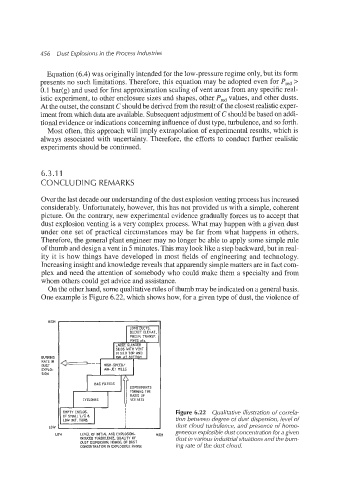Page 489 - Dust Explosions in the Process Industries
P. 489
456 Dust Explosions in the Process Industries
Equation (6.4) was originally intended for the low-pressure regime only, but its form
presents no such limitations. Therefore, this equation may be adopted even for Pred>
0.1 bar(g) and used for first approximation scaling of vent areas from any specific real-
istic experiment, to other enclosure sizes and shapes, other Pred values, and other dusts.
At the outset, the constant C shouldbe derived from the result of the closestrealistic exper-
iment from which data are available.Subsequentadjustmentof C should be based on addi-
tional evidence or indications concerning influence of dust type, turbulence, and so forth.
Most often, this approach will imply extrapolation of experimental results, which is
always associated with uncertainty. Therefore, the efforts to conduct further realistic
experiments should be continued.
6.3.1 1
CONCLUDING REMARKS
Over the last decade our understanding of the dust explosionventing process has increased
considerably. Unfortunately,however, this has not provided us with a simple, coherent
picture. On the contrary, new experimental evidence gradually forces us to accept that
dust explosion venting is a very complex process. What may happen with a given dust
under one set of practical circumstances may be far from what happens in others.
Therefore, the general plant engineer may no longer be able to apply some simple rule
of thumb and design a vent in 5 minutes. This may look like a stepbackward,but in real-
ity it is how things have developed in most fields of engineering and technology.
Increasinginsight and knowledgereveals that apparently simple matters are in fact com-
plex and need the attention of somebody who could make them a specialty and from
whom others could get advice and assistance.
On the other hand, some qualitativerules of thumb may be indicated on a general basis.
One example is Figure 6.22, which shows how, for a given type of dust, the violence of
HiGH
PNEUM. TRANSP.
BURNING
RATE IN
DUST
EXPLO- AIR-JET MILLS
SION
BAG FiLTERS
EXPERIMENTS
FORMING THE
BASIS OF
CYCLONES VDI 3613
EMPTY ENCLOS. Figure 6.22 Qualitative illustration of correla-
OF SMALL L/D &
LOW INIT. TURE. I tion between degree of dust dispersion, level of
LOW dust cloud turbulence, and presence of homo-
LOW LEVEL OF INITIAL AND EXPLOSION- geneous explosible dust concentration for a given
INDUCED TURBULENCE, QUALITY OF dust in various industrialsituationsand the burn-
DUST DISPERSION. HOMOG. OF DUST
CONCENTRATION IN EXPLOSIBLE RANGE ing rate of the dust cloud.

